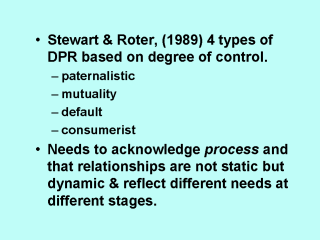| front |1 |2 |3 |4 |5 |6 |7 |8 |9 |10 |11 |review |
 |
More
recently, Stewart & Roter re-classified the three models of the DPR to four:
paternalistic (equivalent to active-passive), mutuality (corresponding to mutual
participation), default (corresponding more loosely to something between the
active-passive and co-operation-guidance) and consumerist, which had equivalent in Szasz
& Hollender’s model. The consumerist perspective acknowledges the fact that patients
increasingly have a choice and means to object or complain if dissatisfied - this may be
professionally or, increasingly, through litigation (suing the doctor). However, all of these models suffer frm the problem of being “state” models - they fail to acknowledge that DPRs are not static states of being but dynamic exchanges which may vary as the needs of the situation vary - at certain times a paternalistic approach is needed - such as when the patient is unconscious in the A&E after an accident, while a week later there is a mutuality or negotiated relationship when the orthopaedic surgeon offers a choice of methods for fixing a damaged limb. The state models were then, superceded by models which tried to accommodate this dynamic element of the DPR. |